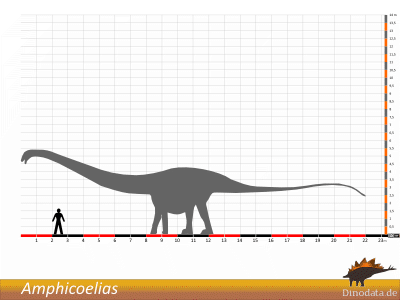
Cope, 1877
Klassifizierung: Diplodocidae
Fortbewegung: quadruped
Ernährung: herbivor
Bedeutung des Namen: etwa "doppelt hohl"
Amphicoelias altus erhielt seinen Namen vom Paläontologen Edward Drinker Cope im Dezember 1877 für ein unvollständiges Skelett, bestehend aus zwei Wirbeln, einem Pubis (Hüftknochen) und einem Femur (Oberschenkelknochen). 1878 entdeckte Cope den Teil eines Wirbels einer weiteren Art in Colorado. Er war sehr groß, aber in schlechtem Zustand. Er beschrieb diese Art als Amphicoelias fragilimus, verpackte den Fund und schickte ihn nach New York, wo der Wirbelknochen jedoch niemals ankam.
Die einzigen Überreste sind eine Skizze sowie die Beschreibung, daher gilt A. fragilimus als sehr zweifelhafte Art. Der stark fragmentierte und unvollständige Wirbelknochen des Amphicoelias fragilimus ging leider verloren. Im Jahr 2018 beschrieb Kenneth Carpenter A. fragillimus als neue Gattung Maraapunisaurus fragilis. Emanuel Tschopp und sein Team platzierten Amphicoelias im Jahr 2015 im Rahmen in einer umfassenden phylogenetischen Analyse in die Familie der Diplodocidae.
Höhe: 4 m
Länge: 22 m
Gewicht: 20 to
Holotyp: AMNH 5764
Fundort: Morrison Formation, Cope Quarry XII, Colorado, USA

© Dinodata.de

© Mannion et al.
Weitere Informationen
Anatomy and systematics of the diplodocoid Amphicoelias altus supports high sauropod dinosaur diversity in the Upper Jurassic Morrison Formation of the USA / Philip D. Mannion, Emanuel Tschopp, John A. Whitlock, 2021 / Royal Society Open Science 8: 210377.https://doi.org/10.1098/rsos.210377
/ Philip D. Mannion, Emanuel Tschopp, John A. Whitlock, 2021 / Royal Society Open Science 8: 210377.https://doi.org/10.1098/rsos.210377 PDF
PDF
On the Vertebrata of the Dakota Epoch of Colorado / Edward D. Cope, 1878 / Proceedings of the American Philosophical Society 17: 233–247 /
/ Edward D. Cope, 1878 / Proceedings of the American Philosophical Society 17: 233–247 /  PDF
PDF
Maraapunisaurus fragillimus, N.G. (formerly Amphicoelias fragillimus), a basal Rebbachisaurid from the Morrison Formation (Upper Jurassic) of Colorado / Kenneth Carpenter, 2018 / Geology of the Intermountain West, Volume 5, pp 227–244, 2018
The fragile legacy of Amphicoelias fragillimus (Dinosauria: Sauropoda; Morrison Formation - Latest Jurassic) / Cary Woodruff, John R Foster, 2014 / Volumina Jurassica, 2014, Xii (2): 211–220. DOI: 10.5604/17313708 .1130144
- - - - -
Bildlizenzen
Größenvergleich © Dinodata.de:
 Creative Commons 4.0 International (CC BY 4.0)
Creative Commons 4.0 International (CC BY 4.0)
Wirbelknochen© Mannion et al.:
 Creative Commons 4.0 International (CC BY 4.0)
Creative Commons 4.0 International (CC BY 4.0)



